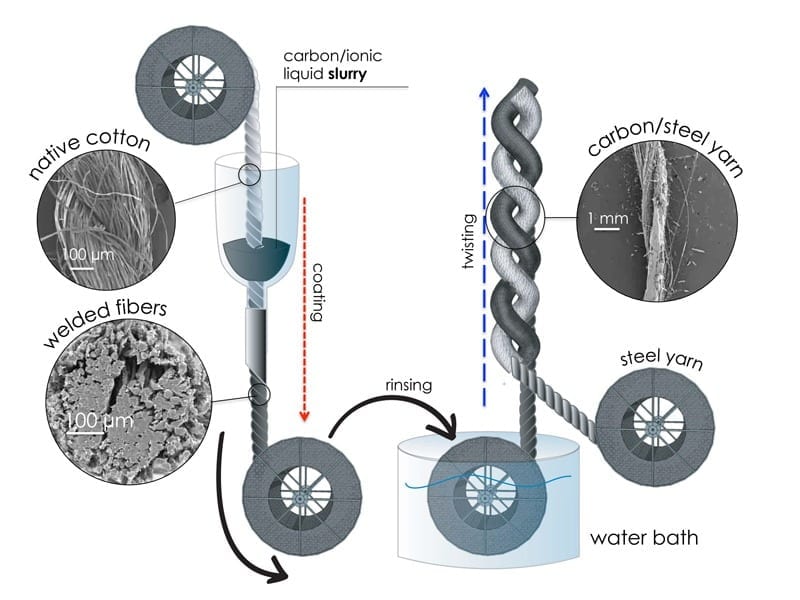
While the pattern for making a wearable fabric battery has already been laid out, it’s now time to select the threads that will turn a textile into an energy storage device.
That process is being driven by Drexel University doctoral student Kristy Jost, who’s threaded her way into the forefront of research on conductive yarns.
Using a process, called “Natural Fiber Welding,” which was developed by collaborator Paul C. Trulove at the U.S. Naval Academy, researchers are embedding functionalized materials—at the molecular level—into a cellulose-based yarn, like cotton. Jost, who is advised by Yury Gogotsi, PhD, Distinguished University and Trustee chair professor in the College of Engineering and Genevieve Dion, director of the Shima Seiki Haute Technology Laboratory and an assistant professor in the Antoinette Westphal College of Media Arts & Design, has taken this process to the next level. She and her team are using NFW to strategically alter yarn for a variety of uses, but the one they’re most interested in is energy storage.
“If energy textiles are going to be realized, figuring out the best way to functionalize our yarn is the first step,” Jost said. “Natural fiber welding is proving to be highly effective in producing yarns that we can tune for particular uses, including energy storage. This work is only possible because of the successful collaboration between Drexel’s Shima Seiki Haute Tech Laboratory, the A.J. Drexel Nanomaterials Institute, and the chemistry department at the U.S. Naval Academy.
To make it happen, the yarn is first treated with a molten salt, which causes the polymer chains to swell, thus opening the structure. Then they embed it with a functional material—such as activated carbon particles—by sliding the yarn through a syringe filled with a mixture of the material in the ionic liquid. The yarn is then pulled through the needle of the syringe, which physically presses the carbon into the fibers, and it is wrapped onto a spool. The ionic liquid is removed by washing the yarn with water, which also re-solidifies the cotton fiber, trapping carbon particles in the surface.
The result is a complex composite fibrous material that retains its original flexibility, but gains the capacitive properties of activated carbon. Much like conventional energy storage devices have metal plates to improve the electrical conductivity, the activated carbon-natural fiber welded yarn is twisted with a highly conductive stainless steel yarn prior to testing. Activated carbon on it’s own is not conductive enough for energy applications, so the stainless steel yarn allows the materials to be charged more easily.
“What’s unique about this process, is that we can use any commercially available yarn made of cellulose—cotton, linen, bamboo, viscose, rayon,” Dion said. “This adds another level of tune-ability, since we can weld thick or fine yarns, containing longer or shorter fibers, which can lead to textiles with unique mechanical properties. We use activated carbon for much of our research because it tends to be skin-friendly, and is commonly found in water filters. The yarn could be embedded with a variety of carbon nanomaterials, but we’re looking ahead at making a wearable garment, so concerns like skin irritation, come into play.”
Read more: Holding Energy By The Threads: Drexel Researchers Spin Cotton Into Capacitive Yarn
The Latest on: Capacitive Yarn
[google_news title=”” keyword=”Capacitive Yarn” num_posts=”10″ blurb_length=”0″ show_thumb=”left”]
via Google News
The Latest on: Capacitive Yarn
- Feed has no items.
via Bing News










